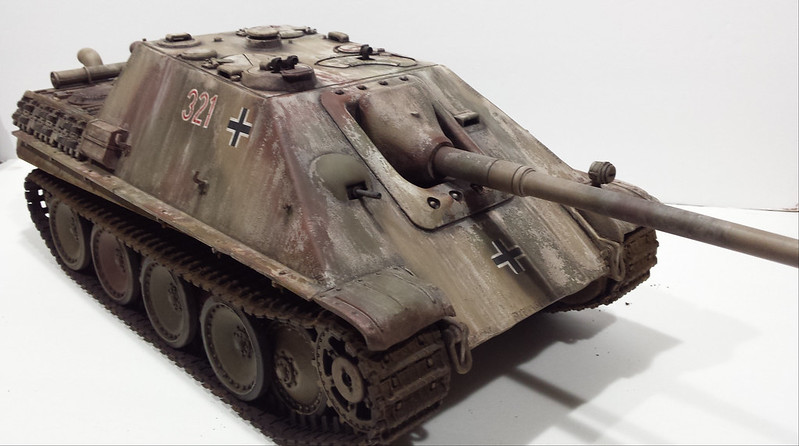Max-U52 wrote:That's really cool, Man. It actually made me think the tank had come out of the factory with a camo paint job, then some time went by and winter came so they white-washed it, then some more time went by and spring came so they tried to wash off the white-wash, and now it's the beginning of summer. Kinda told me a little story, even.

Close? In the right background it could easily be mistaken for the real thing. Again, nice work.

Thanks, yes you are pretty close they just didn't need to scratch it off, the weather did that. This tank would have been issued in late summer leading up to the Battle of the Bulge in the winter of 44 / 45. Then whitewashed during the first snow before the battle then use throughout the battle and into February March in Germany through the spring rains and mud.
Very very rare are winter camouflages from the factory as they were not sure what the area would look like when it got there. The Germans and Russians and eventually the Americans would learn that you cannot whitewash tanks ahead of time because they stand out and make easy targets. You must wait until the snow is falling and has fallen a lot to paint it. The problem with that is that of course it is snowing and the tank is all wet and cold which are horrible conditions for painting. The German whitewash paint was very thin as they had a pigment shortage and had to stretch the paint to have enough to make all of the vehicles whitewashed. So the combination of the cheap paint and the conditions it was applied in caused it to chip off and run off very quickly. Also this had to be done very quickly because if your tank was not camouflaged the next morning after a heavy snowstorm it then stood out like a sore thumb. So many times these were done at night not with a spray gun as they didn't have enough painters to go around quickly enough to get everyone especially on the front line. So most of these winter white washed vehicles were painted with makeshift brushes, mops and even just material found around the area on the end of a stick. This is why if you're doing a whitewash winter camouflage you don't want to do it with an airbrush as the final look. Airbrush is fine if you plan on chipping it streaking it and washing it away but if you want a middle of the winter look use a brush and sometimes not a very good one. You want it to be sloppy you want it to be runny and you want to miss spots.
A trick I used to do before I had a lot of different options and I have learned a lot of different methods was to Simply take White oil based paint and pour it into water and mix it around and then splash it on. It makes for a horrible authentic look of splotchy beautiful white wash. But I do prefer this method that I used on this tank which is the hairspray method of chipping it off as it gives you a little more control.
 20180602_191306 by jon newsom, on Flickr
20180602_191306 by jon newsom, on Flickr 20180602_191112 by jon newsom, on Flickr
20180602_191112 by jon newsom, on Flickr 20180602_191249 by jon newsom, on Flickr
20180602_191249 by jon newsom, on Flickr 20180602_191009 by jon newsom, on Flickr
20180602_191009 by jon newsom, on Flickr 20180602_191147 by jon newsom, on Flickr
20180602_191147 by jon newsom, on Flickr 20180602_190856 by jon newsom, on Flickr
20180602_190856 by jon newsom, on Flickr 20180602_190848 by jon newsom, on Flickr
20180602_190848 by jon newsom, on Flickr 20180602_190657 by jon newsom, on Flickr
20180602_190657 by jon newsom, on Flickr 20180602_190620 by jon newsom, on Flickr
20180602_190620 by jon newsom, on Flickr 20180602_190634 by jon newsom, on Flickr
20180602_190634 by jon newsom, on Flickr